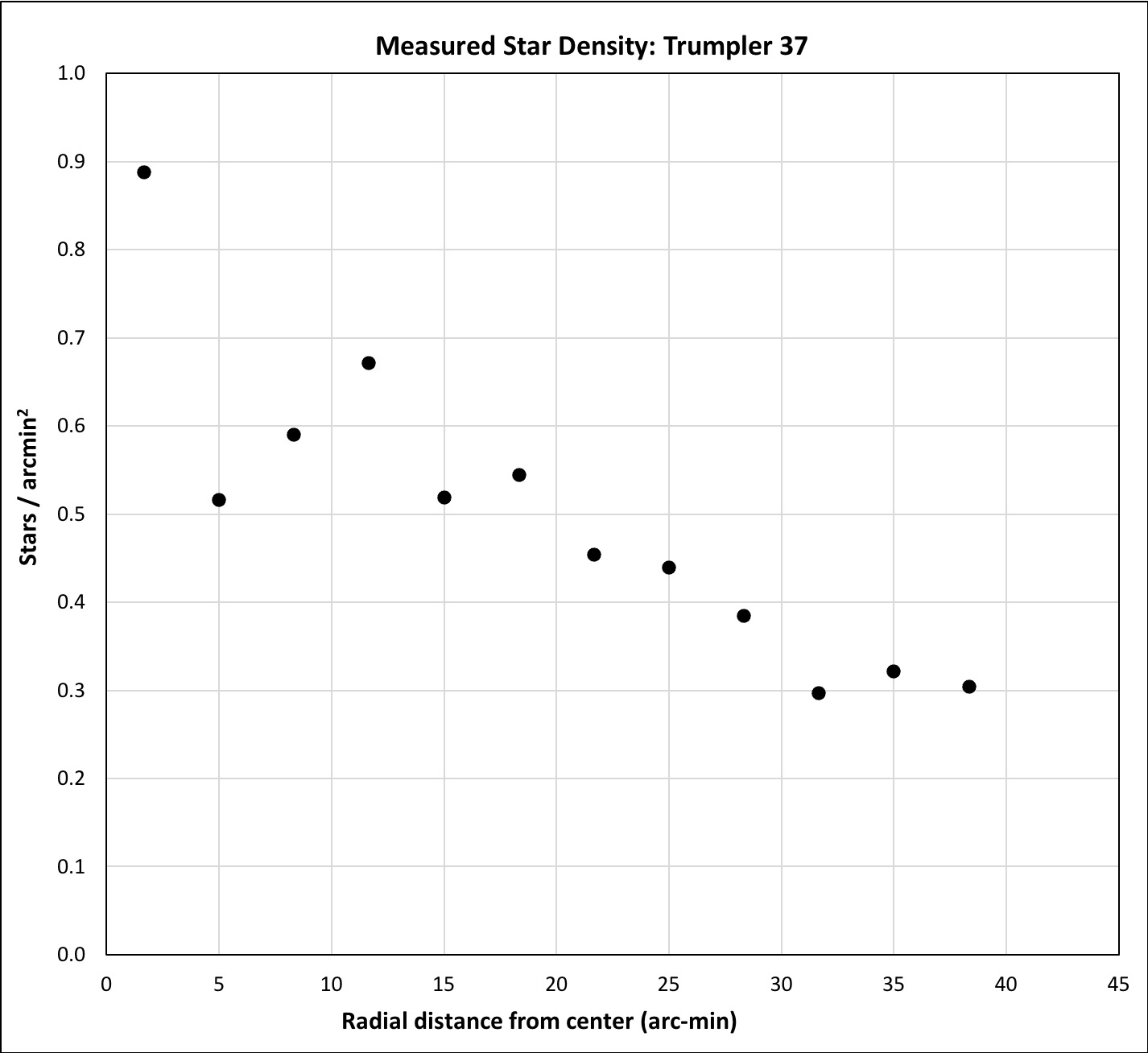Elephant Trunk Region: IC 1396, Trumpler 37 Cluster | |||
| « Previous | Back to Astrophotography Gallery | Next » | |
IC 1396 is a large, roughly circular area of nebulosity in the constellation Cepheus. The entire region is often referred to as the "Elephant Trunk Nebula," based on the long, finger-like structure at mid-height, left side of image (IC 1396A). IC1396 is an emission nebula, meaning that it emits a faint glow caused by ionized gases. In addition to the glowing ionized gas, there are also dark dust clouds (dark regions of image) that extinguish starlight coming from behind the nebula. Embedded in the center of this nebula is an open star cluster designated 'Trumpler 37' (Reference 5). | |||
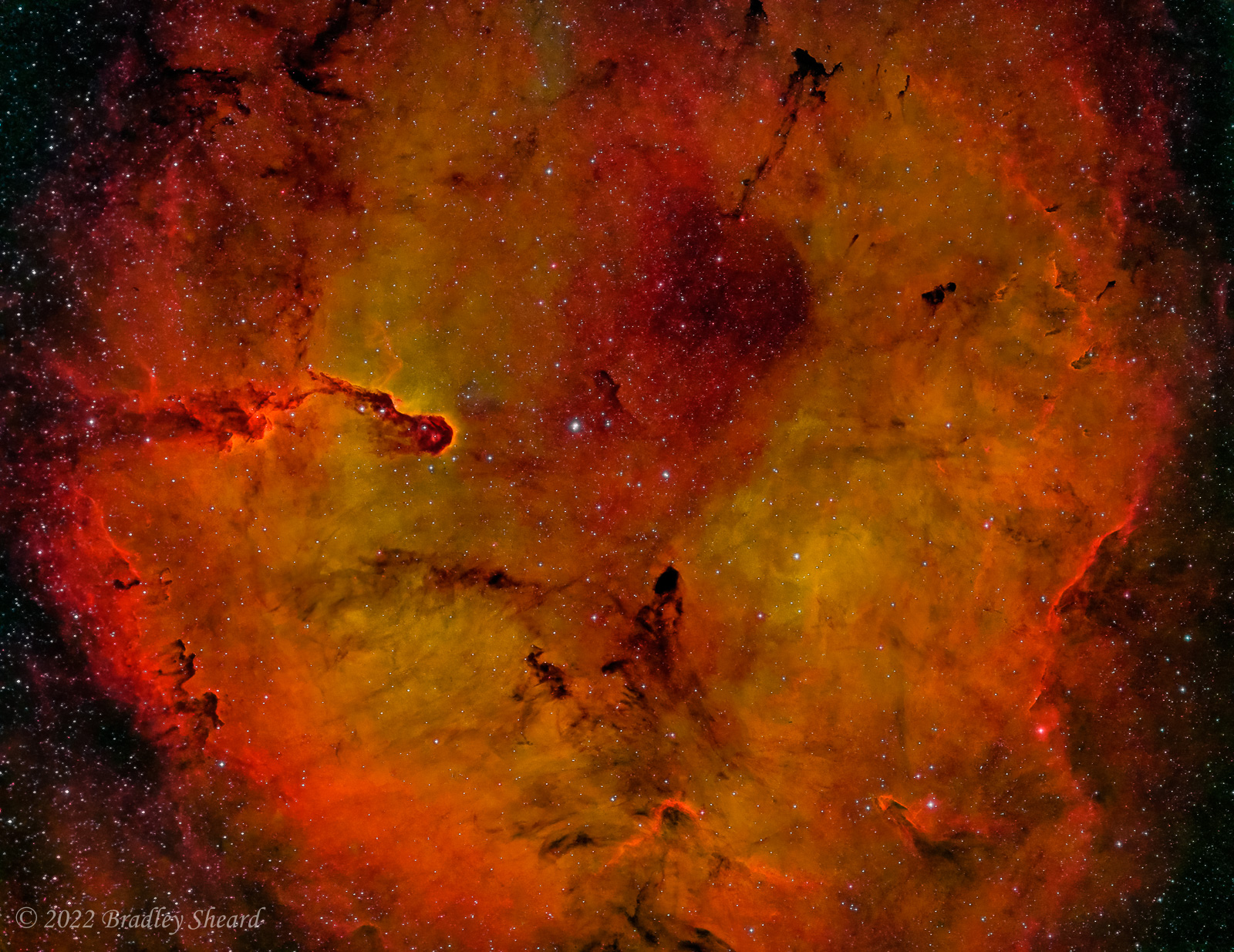 | |||
| Optics: | Williams Optics Star 71 & Stellarvue SVQ-100 | ||
| Camera: | ZWO ASI 1600MM & Starlight Xpress SX-46 | ||
| Exposure info: | 26/23/22 x 10 mins | ||
| Filters used: | Astrodon H-alpha, OIII, SII | ||
| date: | October & November 2018 | ||
| color mapping: | Halpha = Red / O3 = Green / S2 = Blue; w/ modifications | ||
| processing: | Pixinsight-->Photoshop-->Lightroom | ||
The image above was taken through narrowband filters--filters that allow only a thin band of light at very specific wavelengths to pass through to the digital camera. Three such filters were used in the above image: H-alpha (hydrogen, 656 nm), OIII (doubly ionized oxygen, 500 nm) and SII (singly ionized sulfer, 671/673 nm). The resulting image from each filter is then assigned a color channel to make the final, color image. (Note that the color pallete is rather arbitrary, chosen for aesthetic reasons--the colors are not a true reprentation of what the human eye would see). Shown below are the individual image stacks through each filter that were used for the final image. | |||
| H-alpha filter | OIII filter | SII filter |
 |
 |
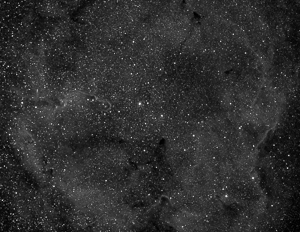 |
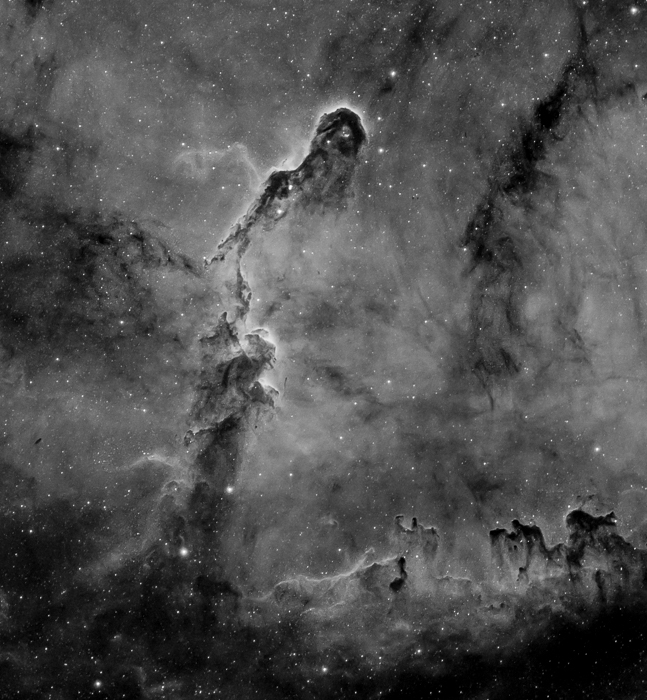 |
| Closer View of the "Elephant Trunk" (rotated ~ 90 degrees) in narrowband H-alpha light |
| (Stellarvue SVQ100 and ZWO ASI 1600MM camera, Astrodon H-alpha filter, 39 x 10 mins) |
 |
The constellation Cepheus, named after King Cepheus (from Greek mythology) of Aethiopia (Ethiopia) lies in the northern sky approximately 25 degrees from the pole star, Polaris. Part of the Milky Way runs through the constellation (shown in red H-alpha below, from SkySafari Pro), making the region rich in emission nebula and popular with astrophotographers. One of the more interesting stars that make up this constellation is &mu Cephei (also called Erakis, or "Herschel's Garnet Star"), at left, lying at the southern end of the constellation, near the emission nebula IC 1396, but just outside the view in the image above. The "Garnet Star" owes its nickname to the deep, red color of this variable, red supergiant. The star is one of the brighest and largest stars known, with a luminosity ~100,000 times that of our sun and a diameter estimated to be ~1,000 times that of the sun. A red super-giant star, it has moved off the 'main sequence' after exhausting the supply of hydrogen in its core, and is believed to now be fusing helium into carbon (Reference 7). The star is destined to become a core-collapse supernova when it has finally exhausted its fuel supply, and with an estimated initial mass of 10-25 solar masses, may well end up as a black hole. |
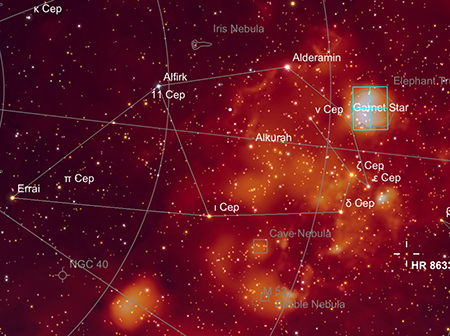 |
|
| Herschel's Garnet Star--&mu Cephei |
Trumpler 37 Open Cluster | |
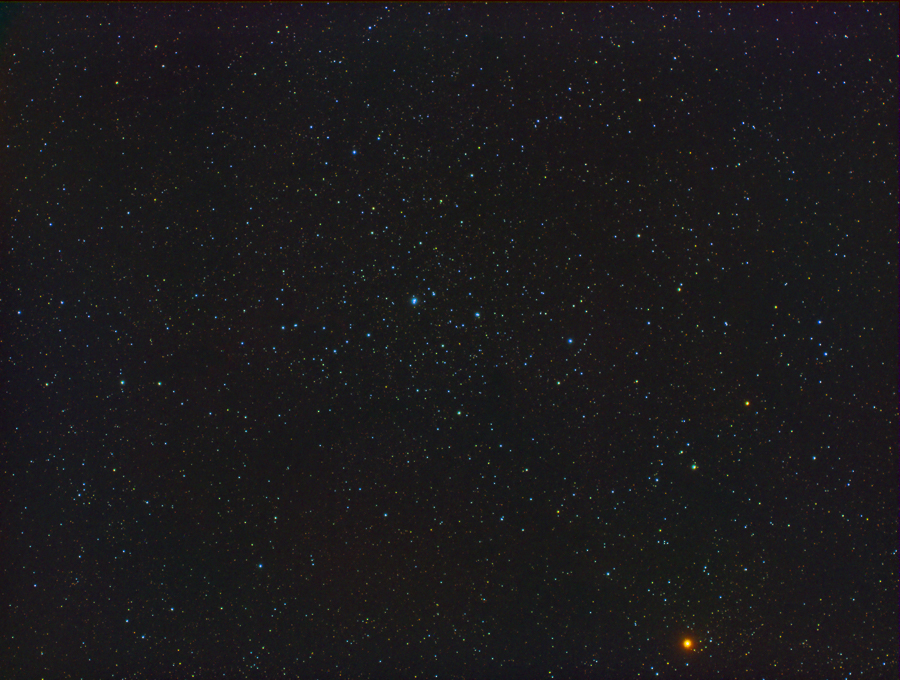
| |
| Open Star Cluster Trumpler 37 | |
| (Williams Optics Star71 and ZWO ASI 1600MM camera, Astronomik RGB filters, 20 x 5 secs each) | |
| Roll-Over for annotated version with H-alpha nebula superimposed on star field |
| Color-Magnitude and H-R Diagram for Star Cluster Trumpler 37 | |||||
| In an attempt to add some "science" to my astro-imaging, I decided to try and make a color-magnitude diagram of the Trumpler 37 cluster lying in the middle of IC 1396. I purchased two photometric filters, Besler "V" and "B", from Chroma.Chroma I then shot a series of images through both filters through two telescopes (William Optics Star 71, 350mm FL and Stellarvue SVT102, 710mm FL--the dotted rectangle in the annotated image above) and a ZWO ASI 1600MM CMOS camera. I took a series of different exposures (which largely proved to be too long!) of 30, 60 and 120 seconds. All of the brighter stars were saturated, so only the dimmer stars were usable for photometry, where I'm trying to accurately measure the brightness of each star. My second attempt was with exposures of 1, 2, 5 and 10 seconds, which was better, but even the 1 second exposures had the brightest stars saturated. | |||||
 |
 | ||||
| Author's Observational Color-Magnitude Diagram for Trumpler 37 Region | Author's H-R Diagram for Trumpler 37 Region | ||||
| (Superimposed on Hipparcos H-R Diagram) | |||||
|
The raw data for the color-magnitude diagrams above were calculated using the 'Aperture Photometry' script in Pixinsight (I am constantly amazed at all the things that Pixinsight can do!). The photometry was performed for 2 different star catalogues, TYCHO-2 (magnitudes 8-13) and APASS (magnitudes 11-16), through 2 different telescopes. The apparent magnitudes (left plot) were corrected for camera quantum efficiency (manufacturer's curve) at the 2 filter wavelengths, and for the 'airmass' correction (path length through the atmosphere). The absolute magnitudes (right plot) were then derived using the interstellar extinction determined in Reference 2, along with the interstellar reddening model of Reference 6. Distance correction was based on a distance of 870 pc. as determined in Reference 2. This is my first attempt at constructing a color-magnitude diagram of a star cluster based on my own data. Surely my data is not perfect, but I was pleased that the data seems to be a reasonable match with the Hipparcos H-R diagram (at least in a general way)! There is also a clear grouping of the majority of stars on the Main Sequence, as well as a large number of stars that have broken off onto the Red Giant Branch. The position of &mu Cephei is not quite correct on the diagram (the color index does not match reference sources). These color magnitude diagrams are for all the photometrically useable stars within a 3000 arc-second (50 arc-minute) circle centered on the star HR8281 (SAO3362, HD 206267) lying at the approximate center of the cluster (Reference 5). According to Reference 3, this star is the primary ionizing star for the nebula. There are surely 'background' stars included in my data that are not members of the cluster Trumpler 37. In total, the plots above include 1040 stars from the TYCHO-2 and APASS catalogues, ranging in apparent magnitudes from 8 to 16.
What is a Color-Magnitude / H-R Diagram? In the early twentieth century two astronomers, Ejnar Hertzsprung and Henry Russell, independently studied available data for stars whose properties had been accurately determined, plotting the stars absolute magnitude on the vertical axis vs. their spectral type on the horizontal axis. The resulting scatter plots showed that the majority of stars fell on a nearly straight diagonal line, now called the 'main sequence.' These diagrams, now called Hertzsprung-Russell (H-R) or color-magnitude diagrams, became an important tool in the study of stellar evolution. An observational color-magnitude diagram plots apparent magnitude vs. color index (roughly proportional to spectral type or effective temperature); these plots are much easier to create since the critical distance to the stars is not needed. If distance information is available, then the absolute magnitudes can be determined and the data replotted to create a true H-R diagram. (Note that stellar distances are one of the most difficult properties to determine.) For a star cluster, however, since the stars are all located at (approximately) the same distance (from earth), the easier-to-construct apparent magnitude diagram is a reasonable approximation of a real H-R diagram. REFERENCES 1. Montarges,Homan,Keller,Clementel,Shetye,Decin,Harper,Royer,Winters,Bertre,Richards, "NOEMA maps the CO J=2-1 environment of the red supergiant &mu Cep," April 2019 2. Errmann, Neuhauser, Marschall, Torres, Mugrauer, Chen, Hu, Briceno, Chini, Bukowiecki, Dimitriov, Kjurkchieva, Jensn, Cohen, Wu, Pribulla, Vanko, Krushevska, Budaj, Oasa, Pandey, Fernandez, Kellerer and Marka, "The Stellar Content of the Young Open Cluster Trumpler 37," 2012 3. Getman, Feigelson, Sicilia-Aguilar, Broos, Kuhn and Garmire, "The Elephant Trunk Nebula and the Trumpler 37 Cluster: Contribution of Triggered Star Formation to the Total Population of an HII Region," Monthly Notices of the Royal Astronomical Society. 2012 4. Marschall, Comins and Karshner, "Photometry of the Young Open Cluster Trumper 37," The Astronomical Journal. May 1990 5. Saurin, Bica and Bonatto, "The Embedded Cluster or Association Trumpler 37 in IC 1396: a Search for Evolutionary Constraints," November 2018 6. Rieke and Lebofsky, "The Interstellar Extinction Law from 1 to 13 microns," The Astrophysical Journal. 1985 January 15 7. Kipper, Tonu, "On the Optical Spectrum of &mu Cephei," Baltic Astronomy. 2010 October 4 8. Hipparcos Hertzsprung-Russel Diagrams ESA Hipparcos | |||||
